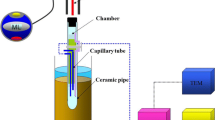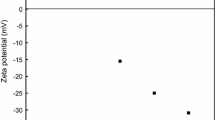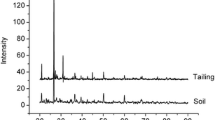Abstract
The role of soil colloids and their potential to co-transport agrochemicals in subsurface soil environments was evaluated in aleaching experiment utilizing large soil monoliths. The monolithswere created by hydraulically driving steel pipe sections (50 cm diameter × 50 cm length) into Maury silt loam (fine, mixed, mesic Typic Paleudalf) and Loradale silt loam (fine, silty, mixed mesic Typic Argiudoll) soils. Water dispersible colloids fractionated from the Bt horizons of the above soilswere spiked with 3 mg L-1 atrazine (2-chloro-4-ethylamino-6-isopropylamine-s-triazine) and 10 mg L-1 zinc (Zn), and after a twenty-four hour equilibration were applied into the monoliths at eight hour intervals using 500 mL pulse applications. Solutions containing atrazine and Znwithout added colloids were applied to separate monoliths from each soil to represent control treatments. Colloid, atrazine, andZn recoveries in the eluent varied greatly with respect to soiltype. Colloid recovery in the Loradale monoliths averaged 65.1 ± 26.5%, with maxima approaching the input level, while in the Maury monoliths the average recovery was low (5.7 ± 6.2%) and never exceeded 25% of the input level. Atrazine eluted from the two monoliths averaged 40.3 ± 12.5% (Loradale) and 29.0 ± 20.0% (Maury), with considerable enhancement in the presence of colloids, especially in the Loradale soil. In contrast, the elution of Zn averaged 3.0 ±3.2%, in the Loradale monoliths and rarely exceeded control concentrations in the Maury monoliths, suggesting a stronger retardation of Zn over atrazine within the soil matrix, especially when colloid transport was deterred. Settling-rateexperiments at varying pH and electrical conductivity (EC) valuessuggested that the transport of Maury colloids may have been hindered due to flocculation within the monoliths, while the Loradale colloids remained stable throughout the leaching experiment. Although the presence of colloids enhanced atrazineelution in all monoliths, the actual amount of atrazine transported bound to either colloid type was minimal, suggestingmainly physical exclusion transport processes. In contrast, stronger chemisorption of Zn to colloid surfaces than the soil matrix appeared to enhance the transport of Zn by both colloids.
Similar content being viewed by others
References
Barton, C. D. and Karathanasis, A. D.: 2002, 'A novel method for measurement and characterization of soil macroporosity', Commun. Soil Science and Plant Analysis 33, 1305–1322.
Corapcioglu, M. Y. and Jiang, S.: 1993, 'Colloid-facilitated groundwater contaminant transport', Water Resour. Res. 29, 2215–2226.
Förstner, U.: 1995, 'Land Contamination by Metals: Global Scope and Magnitude of Problem', in H. E. Allen, C. P. Huang, G.W. Bailey and A. R. Bowers (eds), Metal Speciation and Contamination of Soil, Lewis Publishers, Boca Raton, FL, U.S.A., pp. 1–33.
Goldberg, S., Kapoor, B. S. and Rhoades, J. D.: 1990, 'Effect of aluminum and iron oxides and organic matter on flocculation and dispersion of arid zone soils', Soil Science. 150, 588–593
Ibaraki, M. and Sudicky, E. A.: 1995, 'Colloid-facilitate contaminant transport in discretely fractured porous media 1. Numerical formulation and sensitivity analysis', Water Resour. Res. 31, 2945–2960.
Jekel, M. R.: 1986, 'The stabilization of dispersed mineral particles by adsorption of humic substances', Water Resour. Res. 20, 1543–1554.
Karathanasis, A. D.: 1999, 'Subsurface migration of Cu and Zn mediated by soil colloids', Soil Sci. Soc. Amer. J. 63, 830–838.
Klute, A. and Dirksen, C.: 1986, 'Hydraulic Conductivity and Diffusivity: Laboratory Methods', in A. Klute (ed.), Methods of Soil Analysis, Part 1. Physical and Mineralogical Methods-Agronomy Monograph No. 9, 2nd Ed., American Society of Agronomy, Madison,WI, U.S.A., pp. 687–735.
Kolpin, D. W., Barbash, J. E. and Gilliom, R. J.: 1998, 'Occurrence of pesticides in shallow groundwater of the United States: Initial results from the National Water-Quality Assessment Program', Environ. Sci. Technol. 32, 558–566.
Kretzschmar, R., Robarge, W. P. and Amoozegar, A.: 1995, 'Influence of natural organic matter on colloid transport through saprolite', Water Resour. Res. 31, 435–445.
Liang, L. and McCarthy, J. F.: 1995, 'Colloidal Transport of Metal Contaminants in Groundwater', in H. E. Allen, C. P. Huang, G. W. Bailey and A. R. Bowes (eds), Metal Speciation and Contamination of Soil, Lewis Publishers, Boca Raton, FL, U.S.A., pp 87–112.
McBride, M. B.: 1989, 'Surface Chemistry of Soil Minerals', in J. B. Dixon and S. B. Weed (eds), Minerals in Soil Environments. Soil Science Society of America,Madison,WI, U.S.A., pp. 35–88.
McDaniel, P. A. and Buol, S.W.: 1991, 'Manganese Distributions in Acid Soils of the North Carolina Piedmont', Soil Sci. Soc. Amer. J. 55, 152–158.
McDowell-Boyer, L. M., Hunt, J. R. and Sitar, N.: 1986, 'Particle transport through porous media', Water Resour. Res. 22, 1901–1922.
Mills, W. B., Liu, S. and Fong, F. K.: 1991, 'Literature review and model (COMET) for colloid/metal transport in porous media', Ground Water 29, 199–208.
Morrison, R. T. and Boyd, R. N.: 1973, Organic Chemistry. 3rd (ed.), Allyn and Bacon, Boston, MA, U.S.A., 638 pp.
Natural Resources Conservation Service.: 1996, Soil Survey Laboratory Methods Manual. Soil Survey Investigations, Report No. 42. United States Department of Agriculture, Washington, DC, U.S.A.
Oades, J. M.: 1989, 'An Introduction to Organic Matter in Mineral Soils', in J. B. Dixon and S. B. Weed (eds), Minerals in Soil Environments, Soil Science Society of America, Madison, WI, U.S.A., pp. 89–160.
Ouyang, Y., Shinde, D., Mansell, R. S. and Harris, W.: 1996, 'Colloid-enhanced transport in subsurface environments: A review', Crit. Rev. Environ. Sci. Technol. 26, 189–204.
Puls, R. W., and Powell, R. M.: 1992, 'Transport of inorganic colloids through natural aquifer material: Implications for contaminant transport', Environ. Sci. Technol. 26, 614–621.
Radke, R. O., Armstrong, D. E. and Chesters, G.: 1966, 'Evaluation of the pyridine-alkali colorimetric meth for determination of atrazine', J. Agricult. Food Chem. 14, 70–73.
SAS Institute.: 1990, SAS procedure guide, version 6, 3rd (ed.), SAS Inst., Cary, NC, 320 pp.
Senesi, N. and Testini, C.: 1982, 'Physico-chemical investigations of interaction mechanisms between s-triazine herbicides and soil humic acids', Geoderma 28, 129–146.
Seta, A. K. and Karathanasis, A. D.: 1997a, 'Stability and transportability of water-dispersible soil colloids', Soil Sci. Soc. Amer. J. 61, 604–611.
Seta, A. K. and Karathanasis, A. D.: 1997b, 'Atrazine adsorption by soil colloids and co-transport through subsurface environments', Soil Sci. Soc. Amer. J. 61, 612–617.
Shuman, L. M.: 1985, 'Fractionation method for soil microelements', Soil Sci. 140, 11–22.
Stevenson, F. J. and Fitch, A.: 1986, 'Chemistry of Complexation of Metal Ions with Soil Solution Organics', in P. M. Huang and M. Schnitzer (eds), Interactions of Soil Minerals with Natural Organics and Microbes. SSSA Special Publication No. 17. Soil Science Society America, Madison, WI, U.S.A., pp. 29–58.
Triegel, E. K. and Guo, L.: 1994, 'Overview of the Fate of Pesticides in the Environment, Water Balance; Runoff vs. Leaching', in R. C. Honeycutt and D. J. Schabacker (eds), Mechanisms of Pesticide Movement into Ground Water. Lewis Publishers, Boca Raton, FL, U.S.A., pp. 1–13.
USEPA: 1994, Methods for the determination of metals in environmental samples. EPA/600/R-94/111, Washington, DC, U.S.A. 248 pp.
Author information
Authors and Affiliations
Corresponding author
Rights and permissions
About this article
Cite this article
Barton, C.D., Karathanasis, A.D. Influence of Soil Colloids on the Migration of Atrazine and Zinc Through Large Soil Monoliths. Water, Air, & Soil Pollution 143, 3–21 (2003). https://doi.org/10.1023/A:1022886225564
Issue Date:
DOI: https://doi.org/10.1023/A:1022886225564




